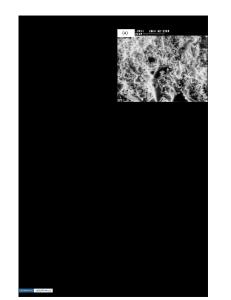Lamellar-like nanostructure in a relaxor ferroelectrics Pb(Mg 1/3 Nb 2/3 )O 3
- PDF / 2,489,662 Bytes
- 11 Pages / 595.276 x 790.866 pts Page_size
- 2 Downloads / 316 Views
Lamellar-like nanostructure in a relaxor ferroelectrics Pb(Mg1/3Nb2/3)O3 Yukio Sato1,* , Syota Fujinaka1, Syo Yamaguchi1, Ryo Teranishi1, Kenji Kaneko1, Takao Shimizu2, Hiroki Taniguchi3, and Hiroki Moriwake4,5 1
Department of Materials Science and Engineering, Kyushu University, 744 Motooka, Nishi, Fukuoka 819-0395, Japan Department of Materials Science and Engineering, Tokyo Institute of Technology, 4259 Nagatsuta, Midori, Yokohama 226-8503, Japan 3 Department of Physics, Nagoya University, Furocho, Chikusa, Nagoya 464-8602, Japan 4 Nanostructure Research Laboratory, Japan Fine Ceramics Center, 2-4-1 Mutsuno, Atsuta, Nagoya 456-8587, Japan 5 Center for Materials Research by Information Integration (CMI2), National Institute for Materials Science (NIMS), 1-2-1 Sengen, Tsukuba, Ibaraki 305-0047, Japan 2
Received: 29 June 2020
ABSTRACT
Accepted: 3 October 2020
The nanostructure of relaxor ferroelectric materials has been a central focus for investigating the microscopic origin of their intriguing physical properties. While it is believed that relaxor ferroelectricity is governed by polar nanostructures, such as polar nanoregions or nanodomains, recent studies have indicated the importance of additional mechanisms, such as the competition of ferroelectric/anti-ferroelectric order and the formation of hierarchical nanodomains. This calls for further investigation on the nanostructure. Here, we used conventional, in situ, and atomic-scale electron microscopy to study prototypic relaxor ferroelectrics, Pb(Mg1/3Nb2/3)O3 (PMN) and Pb(Mg1/3Nb2/3)O3– PbTiO3 (PMN-PT). We found that a lamellar-like nanostructure was present in pure PMN, which had been overlooked in past studies and did not have a strong correlation with the polar nanostructure and the chemically ordered region. Unlike the lamellar-like nanodomains in PMN-PT, the lamellar-like nanostructure in PMN was not coupled with Pb-ion displacement and was not reoriented by the presence of an electric field. The results suggested that the formation of a lamellar-like structure occurs prior to the formation of largerscale polar order in relaxor ferroelectrics.
Ó
Springer Science+Business
Media, LLC, part of Springer Nature 2020
Handling Editor: David Cann.
Address correspondence to E-mail: [email protected]
https://doi.org/10.1007/s10853-020-05417-5
J Mater Sci
Introduction The properties of materials can be controlled via their structural complexity. A natural consequence of introducing structural complexity is that understanding the material structure becomes more difficult because of the considerable increase in the number of parameters to describe [1]. Therefore, clarification of the structure in complex materials has been a major challenge in condensed matter science, and it requires detailed structural investigations over a range of length scales. A typical example is relaxor ferroelectrics; their unique dielectric properties, high dielectric constant (e), and frequency-dependent maximum temperature for e are believed to originate from their na
Data Loading...











